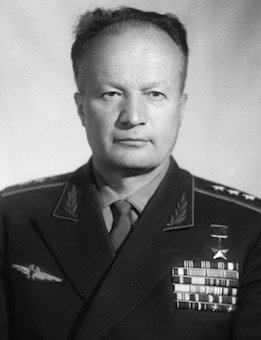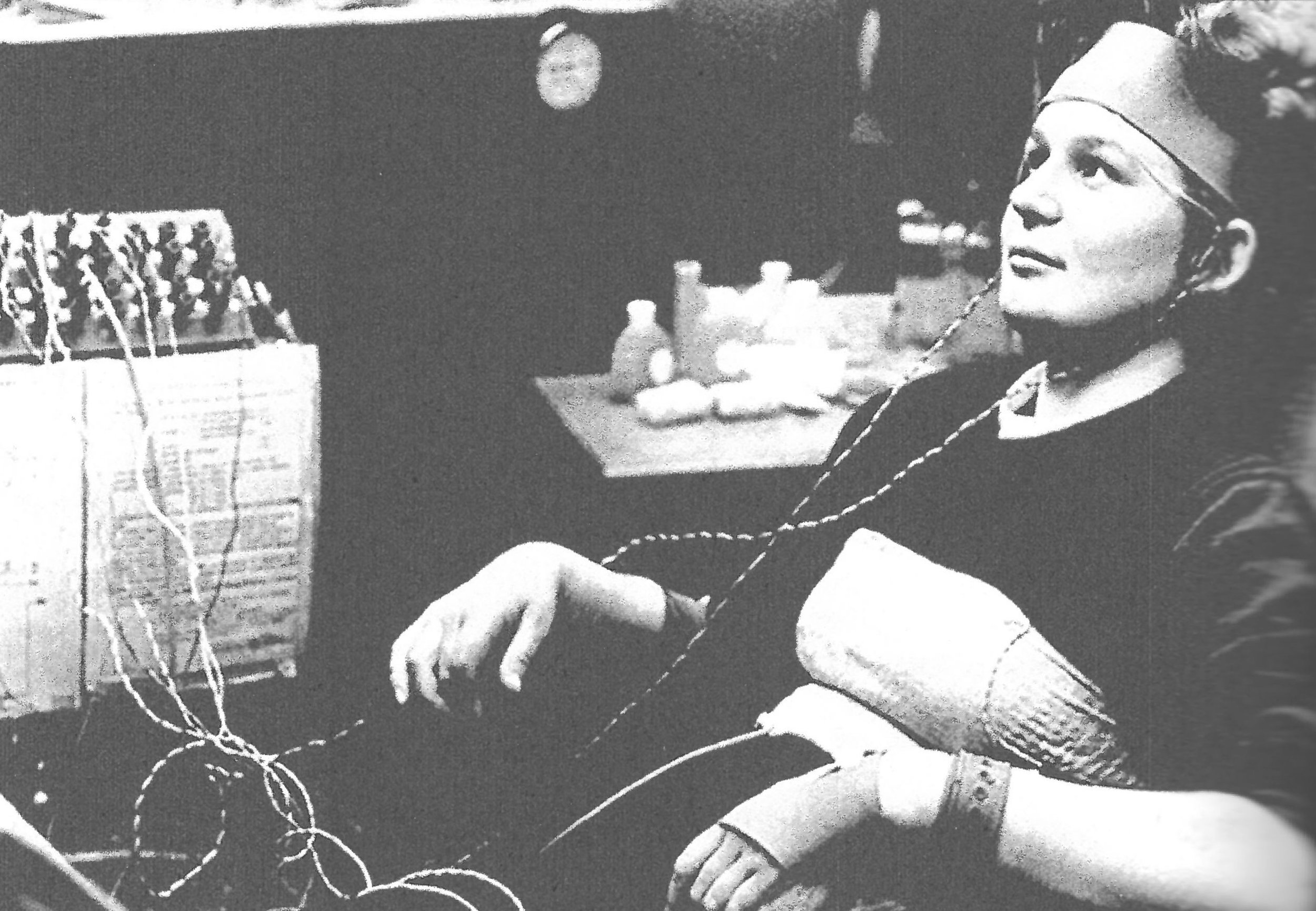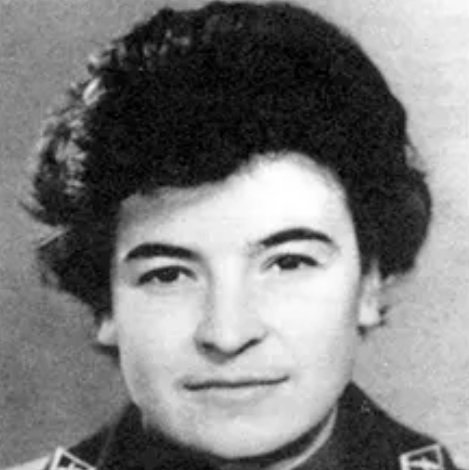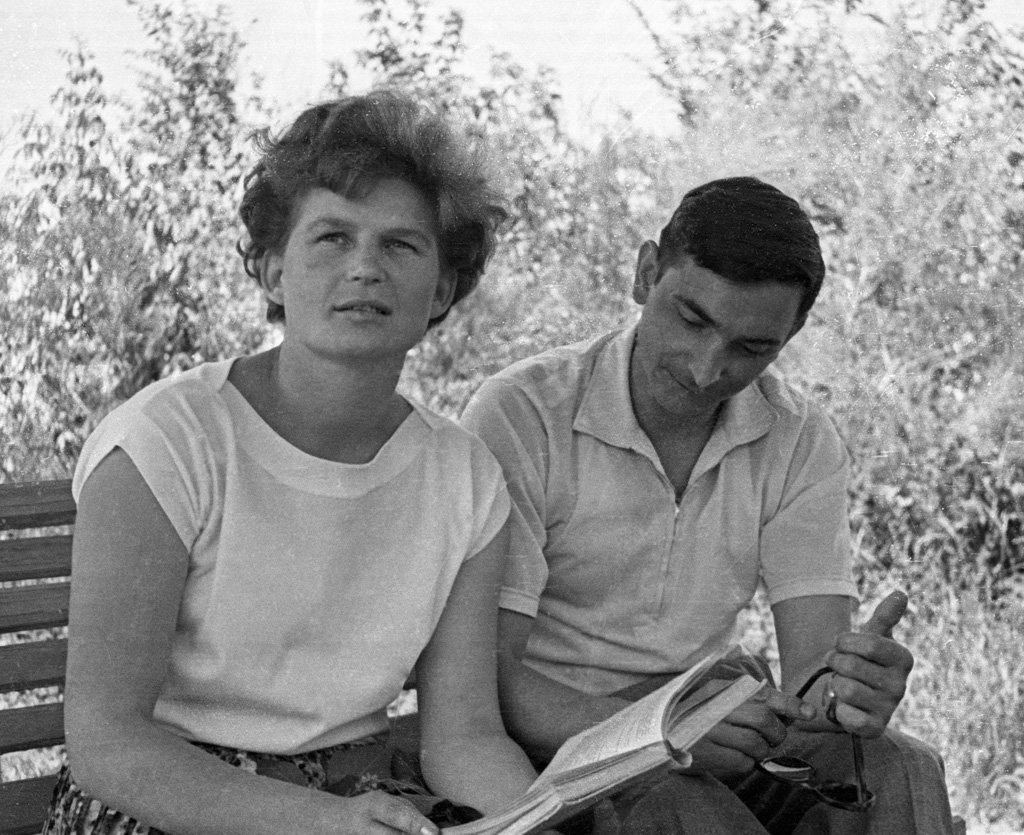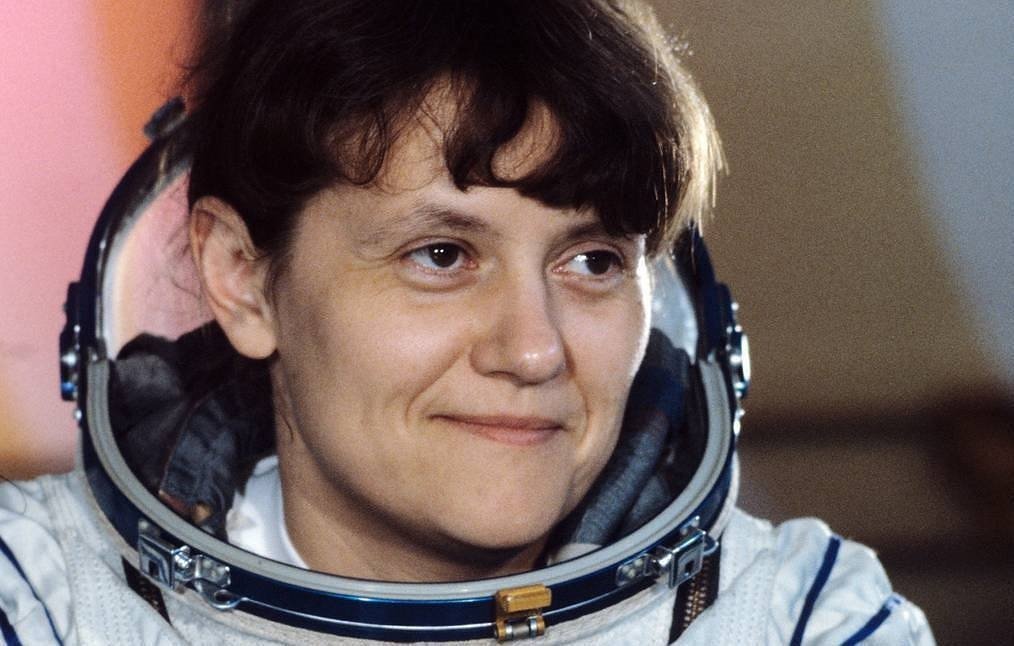
Russian Women in Space
Women Will Fly into Space
Soviet Chief rocket designer and engineer Sergei Pavlovich Korolev supported the choice of Valentina Tereshkova as a cosmonaut, circa 1953. Image credit: esa.int
Valentina Tereshkova, Irina Solovyeva, and Tatyana Kuznetsova.
As the Soviet space program expanded, in 1961, Chief Designer Sergei Korolev indicated the need for 60 new cosmonaut candidates, to include five women. In response to this, Nikolai Kamanin, Assistant to the Deputy Chief Commander of the Air Force and in charge of cosmonaut training, on October 24, 1961, wrote in his diary that:
“In my view, it is necessary to prepare women for space flights mainly for the following reasons:
1. Without doubt women will fly into space, and it is therefore necessary to begin training them as soon as possible.
2. Under no circumstances should an American become the first woman in space. This would be an insult to the patriotic feelings of Soviet women.
3. The first Soviet woman cosmonaut will be as big an active advocate for communism as Gagarin and Titov turned out to be.” —Nikolai Kamanin
Soviet Leader of cosmonaut training General Nikolai Kamanin felt Valentina Tereshkova, Irina Solovyeva, and Tatyana Kuznetsova were the best choices as cosmonaut candidates, circa 1968. Image credit: RIA Novosti
“If women can be railroad workers in Russia, why can’t they fly in space?”
— Valentina Tereshkova, first woman in space
Jumping Through Hoops
The first five female Soviet cosmonauts selected in 1962. From left to right, Valentina Ponomareva, Tatyana Kuznetsova, Irina Solovyeva, Valentina Tereshkova, and Zhanna Yorkina. Image credit: RKK Energiya via NASA
Eligible women were contacted and selected through aviation clubs throughout the Soviet Union. Skydiving was a popular hobby at the time and particular preference was given to physically fit candidates with parachute jumping experience. The Vostok spacecraft required the cosmonaut to land using a parachute, a complex skill which would be hard to train a novice in a short period of time. Candidates had to be under 30 years of age, under 170cm (5’7”) tall, and under 70kg (150 lbs). From the initial 400 women applicants, the group was narrowed down to 58, until five candidates were selected.
In March 1962, the five women chosen to join the male cosmonaut group were Tatyana D. Kuznetsova, Irina B. Solovyeva, Zhanna D. Yorkina, Valentina V. Tereshkova, and Valentina L. Ponomareva.
“I had been trained as a pilot and had only eight jumps. I was a third category jumper; in comparison to the sports master Irina Solovyeva's 800 jumps, my eight jumps were nothing.”
—Valentina L. Ponomareva
Cosmonauts in Training
Soviet cosmonaut Svetlana Savitskaya skydives, circa 1965. Image credit: Museum of Cosmonautics
Soviet cosmonaut Svetlana Savitskaya trains under weightless conditions in the IL-76 test bed, circa 1965. Image credit: Museum of Cosmonautics
Cosmonaut candidate Valentina Tereshkova undergoing monitoring during training, circa 1962. Image credit: tass.com
The five women cosmonauts were enrolled as honorary privates in the Soviet Air Force and followed military regulations. They trained for eighteen months at the Cosmonaut Training Center under the same rigorous conditions to which their male counterparts had been subjected. The women were trained to withstand spaceflight conditions which included weightlessness training; medical and biological testing; centrifuge training; various physical conditioning, such as swimming and gymnastics; spinning chairs; sensory deprivation; heat training; and flight simulations.
Soviet cosmonaut Valentina Tereshkova performs test training on the gymnastic wheel during preflight preparations, circa 1963. Image credit: The First Lady of Space, SpaceHistory101.com
They further practiced their parachute jumping as well, performing up to 120 jumps during training. Specialists from Korolev’s Design Bureau gave lectures on the Vostok spacecraft and other instructors provided lectures on theoretical topics – rocket technology, astronomy, aeronautics, navigation, and other sciences related to the technical side of spaceflight. The program would be complete after final examinations, at which time the women were allowed to become Air Force officers.
Cosmonaut Valentina Tereshkova eating in a Vostok flight simulator, circa 1963. Image credit: soviet-postcards.com
“The requirements [for being a cosmonaut] are very strict. They include readiness to take risks, the sense of utter responsibility...But the cosmonaut must also possess such qualities as curiosity and the ability to break the rules.”
—Valentina L. Ponomareva, The Female Face of the Cosmos
The Candidates
Tatyana D. Kuznetsova
Valentina V. Tereshkova
Irina B. Solovyeva
Zhanna D. Yorkina
Valentina L. Ponomareva
1. Tatyana D. Kuznetsova (b. 1941-d. August 28, 2018): By 20, Kuznetsova was a regional and national parachuting champion when selected for the female cosmonaut group. She was a senior laboratory assistant at the Moscow Institute of Radio Technics. Kuznetsova became ill and did not take the final examination in 1962. She also was taken out of the running as she performed poorly in the pressure chamber and centrifuge training.
2. Irina B. Solovyeva (b. September 6, 1937- ): Solovyeva was a member of the Soviet’s national world champion skydiving team at age 24 and an engineer with a science degree from Ural University when she was selected. She already had 800 parachute jumps under her belt; however, she was not a pilot.
3. Zhanna D. Yorkina (b. May 6, 1939-d. May 25, 2015): Yorkina was a parachuting hobbyist and English language teacher when selected; she was also not a pilot. Yorkina attended the Ryazan Pedagogical Institution. During training, Yorkina hurt her leg during a skydiving session, and as a result, was forced to take a three-month leave of absence to heal. She did graduate from the program, but it wasn’t enough for her to catch up to the other candidates, eliminating her chances of becoming the first woman in space.
4. Valentina V. Tereshkova (only one who flew – see below)
5. Valentina L. Ponomareva (b. September 18, 1933- ) : Ponomareva was probably the most qualified and as technically accomplished as the male cosmonauts. She had only eight parachute jumps when she was selected, but she was the only pilot in the group, with 320 flying hours accrued on PO-2 and Yak-18 aircraft. She also had a degree from Moscow Aviation Institute. Ponomareva worked at the Applied Mathematics Division of the Mathematical Institute of the Soviet Academy of Sciences when she was selected as a cosmonaut.
“Once you’ve been in space, you appreciate how small and fragile the Earth is.”
— Valentina Tereshkova
Tereshkova vs. Ponomareva
Women cosmonauts, left to right, Valentina Ponomareva, Irina Solovyeva, and Valentina Tereshkova on June 16, 1963. Image credit: NASA/Asif Siddiqi/archive.org
Two factions within the Soviet space program leadership fought over which woman would be the first in space. Korolev and Kamanin preferred Tereshkova. She was physically fit and came from a blue-collar background. She was quite active in the Communist Party from a young age, being the Secretary for the Komsomol Committee at the textile factory where she worked. Although Ponomareva was best qualified, Cosmonaut Yuri Gagarin felt she should not fly because she was a mother. Additionally, Ponomareva was also deemed to have “unsteady” morals – she was independent, self-assured, drank at times, smoked, and took walks – all while being a mother. The final decision rested with Soviet Leader Nikita Khrushchev himself who preferred Tereshkova as he believed she better represented the ideal Soviet woman, with her working-class background in the textile industry and her dedication to the Communist party.
“When in orbit, one thinks of the whole of the Earth, rather than of one’s country, as one’s home.”
— Svetlana Savitskaya, Russian Cosmonaut
First Woman in Space -
“Gagarin in a Skirt”
Cosmonauts Valentina Tereshkova and Valery Bykovsky during preflight activities, June 1, 1963. Image credit: RIA Novosti archive, image #67418 / Alexander Mokletsov / CC-BY-SA 3.0
On June 16, 1963, Cosmonaut Valentina Tereshkovna was launched in the spacecraft Vostok 6, which completed 48 orbits in 71 hours. She became the first woman to fly in space. Credit:
Valentina Vladimirova Tereshkova was officially chosen to be the first woman in space. Kamanin referred to her as “Gagarin in a skirt.” Solovyeva would be her backup and Ponomareva became the second backup. By the time of launch, only Tereshkova and Solovyeva were actively involved with activities on the launch pad, while Ponomareva was relegated to ground support.
“…I got nervous right before the start…Yuri Gagarin noticed it, but instead of saying something that would make me calm, he sympathized with me, “I understand you. It’s hard to be the first.”
— Valentina V. Tereshkova, The First Lady of Space
Tereshkova was born March 6, 1937, in Maslennikovo, Russia where she finished school by correspondence. An amateur parachutist hobbyist, she performed her first jump at age 22 in 1959. She was not a pilot but had performed 126 parachute jumps at the time of her selection as a cosmonaut. She became the first woman to fly to space on June 16, 1963, in the Vostok 6 spacecraft. Her call sign was “Chaika,” meaning “Seagull.”
Tereshkova had a perfect launch, orbited the Earth 48 times, and spent almost three days in space. Fellow cosmonaut Valery Bykovsky went up on Vostok 5 two days earlier on June 14, 1963. Tereshkova’s Vostok 6 rendezvoused within three miles of Bykovsky’s spacecraft. At the completion of the mission, she ejected safely from the spacecraft, with a parachute landing on June 19, 1963.
“I am Chaika. I see the horizon. There is a blue stripe. This is the Earth. How beautiful it is! Everything is going well!”
— Valentina Tereshkova, quote from orbit
The Seagull Returns Home
The U.S.S.R. pilot cosmonaut Valentina Tereshkova, the first female cosmonaut, Hero of the Soviet Union in the embassy of the People's Republic of Bulgaria, Moscow. September 1, 1963. Image credit: RIA Novosti archive, image #612195/Saikov/CC-by-SA 3.0
Soviet cosmonauts (front row, from left): Vladimir Komarov, Yuri Gagarin, Valentina Tereshkova, Andriyan Nikolayev, Konstantin Feoktistov, Pavel Belyayev. Back row from left: Aleksei Leonov, Gherman Titov, Valery Bykovsky, Boris Yegorov, and Pavel Popovich. Star City, July 1, 1965. Image credit: RIA Novosti archive, image #888102 / Alexander Mokletsov / CC-BY-SA 3.0
When Tereshkova returned to Earth, news reels shown to the public were of a happy, smiling female cosmonaut after landing. However, these film clips were staged earlier, during successful practice parachute jumps, as she was quite ill during the actual Vostok 6 landing. The status of her health throughout the entire mission has been very much under debate.
Tereshkova went on worldwide goodwill tours, celebrating all the “first” accomplishments of the Soviet Union in space, along with her compatriots. She received the “Hero of the Soviet Union” medal, the “Order of Lenin” award, and the Gold Star medals, among many other awards. On November 3, 1963, under a state-hosted wedding, she married fellow cosmonaut, Andriyan Nikolayev. They had one daughter, Elena, in June 1964. Tereshkova remained active in the Soviet and Russian political arena, and currently is a member of the Russian State Duma (lower assembly of the Federal Assembly of Russia). She still retains the record of being the youngest woman in space (26 at the time of launch) and the only woman to have been on a solo space mission. Tereshkova never flew in space again.
Although the five women: Tatyana D. Kuznetsova, Irina B. Solovyeva, Zhanna D. Yorkina, Valentina V. Tereshkova, and Valentina I. Ponomareva continued training as cosmonauts, the group disbanded in October 1969 when the Soviet Union abandoned the Vostok programme in favor of developing the new Voskhod spacecraft and cancelled plans for further women’s flights.
“Weightlessness did not arouse any unpleasant sensations ... The bread was dry and so I didn’t eat it. The juice and the cutlet were pleasing. I threw up once, but this was due to the food, not due to any vestibular disorder.”
—Valentina Tereshkova
Following in Tereshkova’s Footsteps
Cosmonaut Svetlana Savitskaya, circa 1984. Image credit: Albert Pushkarev/TASS
STS-84 crewmembers Edward Lu, Jean-Francois Clervoy, and Yelena Kondakova in the Spacehab module aboard Space Shuttle Atlantis, May 1997. Image credit: NASA
Russian cosmonaut Yelena Serova, Expedition 41 flight engineer, poses for a photo near a hatch in the Russian segment of the International Space Station, September 27, 2014. Image credit: NASA
Official portrait of Soyuz MS-19/65S crew actress Yulia Peresild, cosmonaut Anton Shkaplerov, and director Klim Shipenko, August 26, 2021. Image credit: NASA
SpaceX Crew-5 Official Crew Portrait with Anna Kikina, Josh Cassada, Nicole Mann, and Koichi Wakata, February 7, 2022. Image credit: NASA
Five more Russian women would fly in space, but not until nineteen years had passed by.
Svetlana Y. Savitskaya
Savitskaya performed more than 400 parachute jumps before she was 18 years old. A world-record holding parachute jumper and test pilot, Savitskaya launched aboard the Soyuz T-7 on August 19, 1982, on a mission to fly to the Russian Salyut 7 Space Station, along with cosmonauts Leonid Popov and Aleksandr Serebrov. Two years later she followed up with her second flight on July 17, 1984, aboard the Soyuz T-12, again to Salyut 7 with cosmonauts Vladimir Dzhanibekov and Igor Volk. On this flight Savitskaya became the first woman to perform a spacewalk. Savitskaya had many other achievements as well:
First woman to reach 2,683 kph in a MiG-25 aircraft
Second woman in space
First woman to fly in space twice
First person to cut and weld metal in space on her spacewalk
First woman to visit a space station
See Sveltana Savitskaya’s sokol suit on display at the Cosmosphere.
Yelena V. Kondakova
Kondakova made her first trip to space on the Soyuz TM-20 on October 4, 1994. She had several achievements as the third Russian woman in space:
First woman to visit the Mir Space Station
First woman to make a long-duration spaceflight, with a five-month stay on the Russian Mir Space Station
First Russian woman on a U.S. space shuttle, flying on STS-84 as a flight specialist, May 15, 1997
First woman to travel in two different spacecraft, Soyuz TM-20 and Space Shuttle Atlantis
Yelena O. Serova
Fourth Russian woman to fly in space
First Russian woman cosmonaut to live and work on the International Space Station (ISS)
Lived and worked on the ISS for 167 days
Deputy in the State Duma of Russian Federation between 2016 and 2021
Yulia Peresild
First professional actress to fly and perform in space. Peresild is a Russian actress who filmed footage for the movie, “The Challenge,” aboard the International Space Station. She launched October 5, 2021, aboard the Soyuz MS-19, filmed for 11 days and returned on October 17, 2021, aboard the Soyuz MS-18.
Anna Y. Kikina
Kikina is the only active female cosmonaut as of 2023.
Launched aboard the commercial SpaceX Crew-5 with Expedition 68/69 to the ISS on October 5, 2022. She returned to Earth on March 11, 2023.
Total time in space was 157 days, 10 hours, 1 minute
First Russian cosmonaut to fly on a Crew Dragon
First Russian cosmonaut to fly on a U.S. spacecraft since 2002


